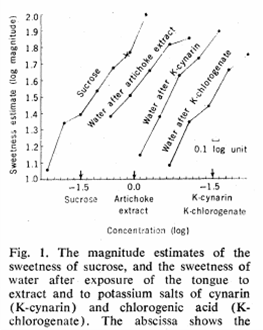Artichokes & that sweet taste
Well here I am in rainy Seattle visiting the inlaws. Last night we prepared artichokes for dinner. Naturally the conversation turned to how the consumption of artichoke has a curious effect on the sense of taste: everything tastes sweet even water. If you've never experienced this before it's because you've never had fresh artichoke. Pickled artichoke hearts don't have this property.
So entering "Artichokes and Sweet Taste" into Pubmed what do you get?
The authors commented that their research was catalyzed by an AAAS dinner which featured artichokes. Using a tasting assay, the researcher discovered two substances in artichoke that stimulate a sweetening of subsequent ingested substances (such as water), chlorogenic acid (3-caffeoylquinic acid) and cynarin (1,5-dicaffeoylquinic acid).
From the original paper:
So entering "Artichokes and Sweet Taste" into Pubmed what do you get?
Bartoshuk LM, Lee CH, Scarpellino R, Sweet taste of water induced by artichoke (Cynara scolymus). Science. 1972 178(64):988-9.
The authors commented that their research was catalyzed by an AAAS dinner which featured artichokes. Using a tasting assay, the researcher discovered two substances in artichoke that stimulate a sweetening of subsequent ingested substances (such as water), chlorogenic acid (3-caffeoylquinic acid) and cynarin (1,5-dicaffeoylquinic acid).
From the original paper:

In other reseach, these two phenolic compounds have been proposed to
- have antimicrobial activities
- act as anti-oxidants
- upregulate Nitrous Oxide Sythetase in exposed tissue
Kurihara K, Beidler LM. Taste-modifying protein from miracle fruit. Science.What else could there be? ... searching more I stumbled into this review:
1968 161:1241-3
Kurihara Y. Characteristics of antisweet substances, sweet proteins, andOK enough Pubmed for me. Have a ... sweet ... holiday.
sweetness-inducing proteins. Crit Rev Food Sci Nutr. 1992 32:231-52.
Abstract.
Recent studies on structures and functions of sweetness-inhibiting substances (gymnemic acid, ziziphin, and gurmarin); sweet proteins (monellin, thaumatin and mabinlin); and taste-modifying proteins (miraculin and curculin) were reviewed. Several gymnemic acid homologues and gurmarin were purified from the leaves of Gymnema sylvestre and their structures were determined. Ziziphin was also purified from leaves of Ziziphus jujuba. Gymnemic acid and ziziphin are glycoside of triterpenes that suppress sweetness in human, while gurmarin is a peptide having antisweet activity in rat. Mabinlin is a heat-stable sweet protein. The whole amino acid sequence and the position of disulfide bridges of mabinlin were determined. Miraculin has the unusual property of modifying a sour taste into a sweet taste. Curculin elicits a sweet taste. In addition, water and sour substance elicit a sweet taste after curculin. Their amino acid sequences and subunit structures were determined. These proteins are expected to be used as low-calorie sweeteners.


<< Home